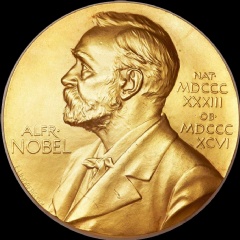NIH Grantee Wins 2017 Nobel Prize in Chemistry
The 2017 Nobel Prize in Chemistry has been awarded to National Institutes of Health grantee Joachim Frank, Ph.D., of Columbia University, New York City. Frank shares the award jointly with Jacques Dubochet, Ph.D., of the University of Geneva and University of Basel, Switzerland, and Richard Henderson, Ph.D., of Cambridge University, for the development (link is external) of cryo-electron microscopy (cryo-EM), which both simplifies and improves the imaging of biomolecules.
The Royal Swedish Academy of Sciences said, “This method has moved biochemistry into a new era.”
Knowing the structure of a molecule reveals important information about how it functions and can provide insight into potential drug targets for fighting disease. Cryo-EM is a method used to image frozen biological molecules without the use of structure-altering dyes or fixatives or the need to coax the molecules into crystalline form, providing a simpler way to generate pictures of the molecules in their normal states and greater understanding of biological function. With cryo-EM, researchers can advance understanding of life’s chemistry and develop pharmaceuticals.
“The work of these Nobel laureates has been game-changing in our understanding of life’s processes and identifying molecular targets for drug development,” said NIH Director Francis S. Collins, M.D., Ph.D. “NIH is investing heavily in the further development of this technology through the NIH Common Funds’ Transformative High Resolution cryo-EM Program, which aims to improve access for researchers through the creation of national service centers, continued advancement of the technology, and developing the skills that researchers need to use this technology. NIH is proud to have supported this groundbreaking research.”
Dr. Frank has received continuous funding from NIH’s National Institute of General Medical Sciences (NIGMS) since 1978, having received more than $25 million in funding to date.
“One of the beauties of this Prize is that it isn’t just looking backward at what happened in the past, it’s also looking to the future,” said NIGMS Director Jon R. Lorsch, Ph.D. “Recent advances in cryo-EM – made possible by the three winners – are allowing us to make unprecedented advances in areas from our basic understanding of cellular processes to the development of new vaccines.”
The Office of the Director, the central office at NIH, is responsible for setting policy for NIH, which includes 27 Institutes and Centers. This involves planning, managing, and coordinating the programs and activities of all NIH components. The Office of the Director also includes program offices which are responsible for stimulating specific areas of research throughout NIH. Additional information is available at https://www.nih.gov/institutes-nih/nih-office-director.
About the National Institutes of Health (NIH): NIH, the nation’s medical research agency, includes 27 Institutes and Centers and is a component of the U.S. Department of Health and Human Services. NIH is the primary federal agency conducting and supporting basic, clinical, and translational medical research, and is investigating the causes, treatments, and cures for both common and rare diseases. For more information about NIH and its programs, visit www.nih.gov.
NIH…Turning Discovery Into Health®
( Press Release Image: https://photos.webwire.com/prmedia/7/214731/214731-1.jpg )
WebWireID214731
This news content was configured by WebWire editorial staff. Linking is permitted.
News Release Distribution and Press Release Distribution Services Provided by WebWire.
